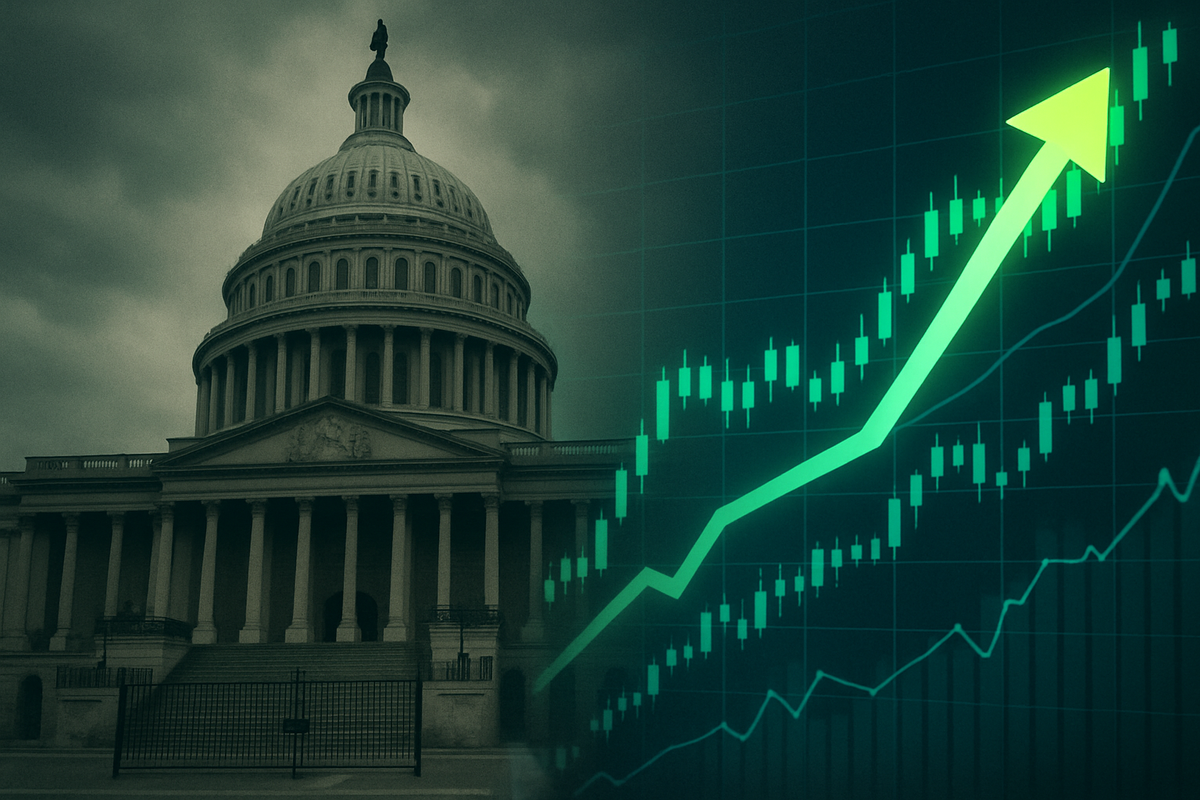
As the United States federal government enters its eighth day of a shutdown, a surprising resilience has characterized the US stock market, with major indices showing remarkable strength despite the political gridlock in Washington D.C. The shutdown, which commenced at 12:01 a.m. EDT on October 1, 2025, has idled hundreds of thousands of federal employees and disrupted numerous government services, yet investors appear largely unfazed, pushing some market benchmarks to new highs.
This ongoing impasse, the 21st funding gap in modern U.S. history and the third under the current Trump presidency, casts a shadow of uncertainty over the nation's economic outlook. While immediate market reactions suggest a degree of investor complacency, analysts warn that a prolonged shutdown could eventually erode confidence, delay crucial economic data, and impact corporate earnings, potentially leading to a more significant market correction down the line.
Political Impasse and Market's Muted Response
The current government shutdown stems from a failure by Congress to pass appropriations legislation for the 2026 fiscal year, which began on October 1. Deep-seated partisan disagreements over federal spending levels, contentious foreign aid rescissions, and the extension of Affordable Care Act (ACA) tax credits—set to expire at the end of 2025—have created an insurmountable barrier to a budget agreement. Furthermore, the Trump administration's reintroduction of "rescissions" to formalize cuts made earlier in 2025 by the Department of Government Efficiency (DOGE) has added another layer of complexity to the budget negotiations.
As of October 8, 2025, the shutdown has forced the furlough of approximately 900,000 federal employees, with an additional 700,000 continuing to work without pay. While critical essential services such as Medicare, Medicaid, and the Transportation Security Administration (TSA) remain operational, a broad spectrum of federal agencies, including the National Institutes of Health (NIH), Centers for Disease Control and Prevention (CDC), and the WIC program, face partial or full suspensions of their operations. The uncertainty surrounding back pay for furloughed workers, despite a 2019 law widely interpreted to guarantee it, adds to the anxiety among federal employees.
Despite this significant disruption, the US stock market's immediate reaction has been notably subdued. On October 1, the day the shutdown began, stocks remarkably closed at record highs. In early trading on October 2, the S&P 400 (SP400) index climbed 8%, extending a three-month winning streak, while both the NASDAQ Composite (NDAQ) and the Dow Jones Industrial Average (DJIA) also posted gains. Historically, the S&P 500 (SPX) has, on average, gained 0.3% during previous shutdowns, suggesting that investors often perceive these events as temporary. In the fixed income market, U.S. Treasury yields remained relatively unchanged on the first business day of the shutdown, though yields generally trended lower across the market, with the 10-year Treasury down to 4.09% and the two-year down to 3.54%, reflecting increased expectations for potential Federal Reserve interest rate cuts. The CBOE Volatility Index (VIX) saw an uptick of over 3%, indicating a natural increase in market uncertainty, while the US Dollar Index (DXY) was down 0.23% on day one, continuing a year-to-date decline of over 11%, signaling a broader lack of confidence in the dollar's value.
Winners and Losers in a Stalled Economy
The ripple effects of a government shutdown, particularly a prolonged one, are not uniform across the corporate landscape. Certain sectors and individual companies are more vulnerable to disruptions, while others may find themselves relatively insulated or even benefit from a "risk-off" environment.
Companies heavily reliant on government contracts, particularly those involved in defense, technology services, and infrastructure projects for federal agencies, are among the most exposed. Delays in contract awards, suspensions of ongoing projects, and delayed payments from federal clients can severely impact their cash flow and revenue recognition. While larger, diversified contractors might weather the storm better due to broader revenue streams, smaller and mid-sized firms with significant government exposure could face acute financial strain, potentially leading to hiring freezes or even layoffs. Specific examples could include major defense contractors like Lockheed Martin (NYSE: LMT) or Boeing (NYSE: BA) if their government payment schedules are disrupted, or IT service providers to federal agencies.
Conversely, defensive sectors and safe-haven assets often see increased interest during periods of political and economic uncertainty. Utilities, consumer staples, and healthcare companies, which typically exhibit more stable demand regardless of economic fluctuations, may attract investors seeking refuge from volatility. Large, well-established companies with strong balance sheets and minimal direct government reliance are also generally better positioned to navigate the turbulence. Additionally, the lower Treasury yields observed during the shutdown suggest a flight to quality in the bond market, benefiting investors holding government debt. Gold and other precious metals, traditionally viewed as safe havens, could also see increased demand as investors seek to hedge against political risk and currency devaluation.
Broader Implications and Historical Context
The ongoing government shutdown carries wider significance beyond immediate market fluctuations, potentially fitting into broader industry trends and impacting the regulatory landscape. One of the most critical implications is the halting of essential economic data releases. Agencies like the Bureau of Labor Statistics (BLS) and the Commerce Department often cease operations, delaying crucial reports such as the monthly jobs report, nonfarm payroll data, and GDP figures. This absence of timely, accurate information leaves investors, businesses, and policymakers, including the Federal Reserve, "flying blind," making informed decisions significantly more challenging and potentially fostering greater market unrest.
A prolonged shutdown could also erode trust in U.S. governance and fiscal stability, both domestically and internationally. This erosion of confidence could have long-term consequences for investment flows, the nation's credit rating, and the dollar's status as the world's reserve currency. Businesses might pause investment and hiring decisions, anticipating sustained uncertainty, which would weigh on overall economic growth and, consequently, corporate earnings and stock prices across various sectors.
Historically, government shutdowns have often been viewed as temporary political theatrics with limited lasting economic impact. Since 1976, the S&P 500 (SPX) has, on average, gained 0.3% during shutdown periods and a robust 13% in the 12 months following their resolution. The longest shutdown in recent history, from late 2018 to early 2019, saw stocks gain more than 10% during its duration. However, the current structural context, marked by significant debates over expiring ACA tax credits and the Trump administration's specific spending rescissions, introduces new variables. This political backdrop suggests that while past market reactions have been benign, the downside risks in this particular shutdown could be more acute, especially if the impasse extends for several weeks or months.
What Comes Next: Navigating Uncertainty
The path forward for the US stock market amidst the ongoing government shutdown is fraught with both short-term volatility and long-term strategic considerations. In the immediate future, markets will closely monitor any signs of progress in congressional negotiations. A swift resolution, perhaps through a short-term continuing resolution, would likely be met with a relief rally, as investors typically discount political impasses as temporary. However, if the shutdown drags on, the cumulative effects of delayed economic data, reduced government services, and growing public frustration could begin to bite, potentially leading to increased market sell-offs and a rotation into more defensive assets.
For businesses, particularly those with federal ties, strategic pivots may be necessary. Companies may need to conserve cash, re-evaluate project timelines, and diversify their client base to reduce reliance on government contracts. For the broader market, potential scenarios include continued muted reactions if investors believe a resolution is imminent, or a more significant downturn if the shutdown triggers broader economic concerns, such as a slowdown in consumer spending or business investment. The Federal Reserve's response will also be critical; prolonged economic uncertainty could increase pressure for interest rate cuts to stimulate growth, which could provide some support to equity markets.
Emerging market opportunities might arise in sectors less dependent on federal spending or those that benefit from a "risk-off" environment. Technology companies focused on private sector innovation, healthcare firms with diverse revenue streams, and companies in the renewable energy sector might prove more resilient. Conversely, challenges will persist for industries heavily regulated by federal agencies or those whose operations are directly impacted by the absence of government permits, inspections, or funding.
Wrapping Up: A Test of Market Resilience
The current US government shutdown presents a compelling test of the stock market's resilience and its ability to distinguish between temporary political theater and fundamental economic threats. While the immediate market reaction has been surprisingly calm, with major indices largely shrugging off the disruption, the underlying risks of a prolonged impasse cannot be overstated. The furlough of hundreds of thousands of federal workers, the suspension of critical government services, and the delay of vital economic data are not trivial matters and could, over time, erode consumer and business confidence.
Moving forward, investors should remain vigilant, focusing on several key indicators. The duration of the shutdown will be paramount; a quick resolution will likely reinforce the market's historical tendency to overlook such events, while an extended shutdown could trigger more significant economic and market repercussions. Watch for any shifts in investor sentiment, particularly indicators of consumer confidence and business spending intentions. The actions and statements from the Federal Reserve regarding monetary policy will also be crucial, as any hints of rate cuts or other stimulus measures could influence market direction.
Ultimately, this event underscores the interconnectedness of politics and economics. While the market has demonstrated a remarkable ability to compartmentalize political drama, there's a limit to how much uncertainty it can absorb without consequence. Investors should prepare for potential increased volatility and consider diversifying their portfolios to mitigate risks associated with political gridlock. The coming weeks will reveal whether this shutdown remains a fleeting distraction or marks a more significant turning point for the US economy and its financial markets.
This content is intended for informational purposes only and is not financial advice






